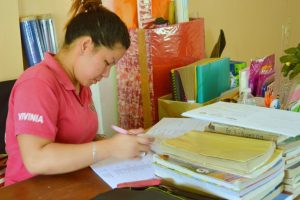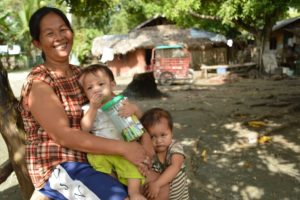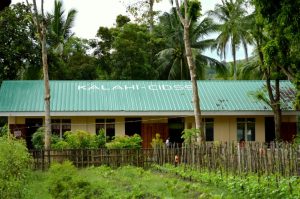
Back in 1997, Vivenia Quizon recalled her school days with the struggle of studying inside a shabby classroom in Hagonghong Elementary School in Buenavista, Quezon Province.
Their classroom was made of sulirap (weaved coconut leaves) walls that have gone dry and weak throughout the years. The room was also too crowded with around 40 students inside as they were sharing it with another grade level.
Their situation was even worse during the rainy seasons as they get soaked and dirty because the room has no flooring and has a dilapidated roof.
Two decades later, Vivenia is back in the same school as a teacher. It hurts her to see that their old classroom hasn’t been changed or even repaired.
“Isa ako sa mga buhay na patotoo na nakaranas ng hirap na makapag-aral sa classroom na iyan. Alam ko ang hirap ng mga estudyante ngayon kaya naman naaawa ako sa kanila. (I can testify as to how hard it is to study in that kind of classroom. I know that the students are now also having a hard time and I feel sorry for them.),” said Teacher Vivenia, 26.
Minda Dival, 44, a resident in the barangay and a mother of students who previously used the classroom, cried the same sentiments.
“Bulok na talaga ang classroom doon. May mga anak akong nag-aral diyan na nakaranas talagang nauulanan sila habang nagkaklase at putikan ang paa. (That classroom is really old and damaged. I have children who experienced getting soaked in the rain and having muddy feet while having classes.),” said Minda.
However, last 2015, Vivenia and Minda, together with the other residents of Brgy. Hagonghong, have found hope that the stories of suffering of school children will finally be ended.
They had the opportunity to build new classrooms when Kapit Bisig Laban sa Kahirapan-Comprehensive and Integrated Delivery of Social Services (Kalahi-CIDSS) program came to their barangay. This community-driven program of the Department of Social Welfare and Development (DSWD) encouraged them to collectively work for the future of the children.
Seizing opportunities
Minda remembered the day back in January 2015 when the residents were gathered in a barangay assembly to discuss the problems of their community and how they can address these. Here, they identified the building of new classrooms to secure the safety of the elementary students.
Their identified project was funded with PhP1.47 Million by the Department of Foreign Affairs and Trade (DFAT) of the Australian Government, a development partner of the DSWD that aims to address significant gaps in education in poor communities. The budget is enough to construct a two-classroom school building for the elementary school.
“Na-prioritize namin ang proyektong dagdag classroom para gumanda naman ang aming school. Para pagdating ng oras, ‘yung mga anak namin, pamangkin at apo ay makakaranas na rin ng magandang paaraalan. (We decided to prioritize the building of additional classrooms to help improve our school. With this, our children, nieces, nephews and grandchildren will have a better school experience in the future.),” Minda added.
The residents were then organized as community volunteers to take charge of the implementation of the project. They were trained on proposal development, financial management and construction estimates to guide them in properly managing the project.

Minda volunteered to be part of the Monitoring and Inventory Team. As a member of the team, she needed to attend weekly volunteers’ meetings and be always available whenever construction materials are delivered to the site.
The schedule was hectic for her since she solely tends to her two toddler grandchildren but she used them as a motivation instead to put more effort in her work.
“’Nung una ay sinabi kong hindi ko kaya dahil may mga apo ako. Pero nasabi ko na lang sa sarili ko, sige, kakayanin ko ‘yan tutal mga apo ko rin naman ang makikinabang ng classroom na iyan balang araw.’(At first, I hesitated to be a volunteer because I was taking care of my grandchildren. But I changed my mind and told myself, ’I will do this for my grandchildren so they can enjoy good classrooms in the future’),” shared Minda.
‘Bayanihan’ for the children
Minda recalled how fascinated she was seeing the residents work together and relive the ‘bayanihan’ spirit while constructing the school building.
She also noticed some women who worked hand-in-hand with men in the construction. Minda realized that the project gave equal opportunities to everyone in the village.
Deodiya Melencio, 40, one of the women-volunteers, shared that the bayanihan spirit and the common goal to improve their school gave her a lot of inspiration to work hard for the project.
“Hindi ramdam ang pagod dahil lahat ay masayang nagtatrabaho. Gusto naming maging maganda ang pagkakayari ng building kaya pinag-aralan ang lahat at tulong-tulong talaga kami. (We don’t feel tired because we are happy at work. Everything was thoroughly studied and everyone worked together because we wanted the building to be beautifully constructed.),” added Deodiya.
Through the residents’ collective efforts, the two-classroom school building was completed last November 2015. The project benefits at least 60 households in the community.

“Ay di ngayon, ang ganda na ng school! Masaya kami dahil ‘yung mga anak at apo namin ay makikinabang sa proyektong pinaghirapan namin. (Now, we have a beautiful school! We are very happy because our children and grandchildren will benefit from the project.)”, Minda said as she joyfully hugs her grandchildren.
As for Teacher Vivenia, she is glad that students of the next generation will have a better experience with their new classrooms. Also, multi-grade classes are no longer necessary as the school finally has enough rooms for every grade level.
“Hindi na mahihirapan ang mga bata. Mas madali na para sa kanila ang mag-aral at matuto. (The students will never have a hard time again to study. It will be easier for them now to learn.),” said Teacher Vivenia.
With all that had happened, the residents of Brgy. Hagonghong are thankful for the opportunities that led them to work as one to improve their elementary school and their community as a whole.
They are all proud to have been a part of collecting good stories from school children as they enjoy a better learning experience and start journeying towards a brighter and better life ahead.#
